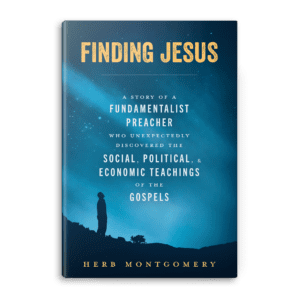
Here at the end of our discussion on safe-for-everyone interpretations and practices, in our reading this week, Jesus speaks of not doing away with the law and the prophets. Jesus’ focus on love and justice as the fulfillment of the law, like Hillel’s, would have been deeply meaningful to Matthew’s original audience. The tensions around debates over the perpetuity of the Torah for Jewish Jesus followers had arisen by the time this gospel was written. This offers us something meaningful today. The Jesus of the gospels led a Jewish renewal movement, not a replacement movement, and that Jewish renewal was built on the foundation of interpreting the Torah through the lens of the Jewish ethics of enemy love, inclusion and embrace of the outsider, economic justice for the poor, and more. This way of interpreting Torah was not antithetical to the Torah.
Welcome Readers! Please subscribe to Social Jesus Here.
(Read this series from the beginning at Part 1 and Part 2.)
Consider the following passages from the Hebrew scriptures:
“If you come across your enemy’s ox or donkey wandering off, be sure to return it. If you see the donkey of someone who hates you fallen down under its load, do not leave it there; be sure you help them with it. (Exodus 23:4-5)
“If your enemy is hungry, give him food to eat;
if he is thirsty, give him water to drink.” (Proverbs 25:21)
“Do not gloat when your enemy falls;
when they stumble, do not let your heart rejoice.” (Proverbs 24:17)
Jesus’ way of interpreting the Torah was one among many. Jesus’ way contrasted with other interpretations that were more formal or that emphasized strict ritual observances to practice Torah faithfulness. But it was these interpretations that Jesus’ teachings contrasted with according to Matthew, not the Torah itself. Jesus’ way of defining faithfulness to the Torah would have also provided his followers with a meaningful alternative to the Temple rituals now they could no longer be practiced.
But, again, Jesus’ teachings were not the only teachings offering alternatives. Karen Armstrong gives another example:
“In Rabbinic Judaism, the Jewish Axial Age came of age. The Golden Rule, compassion, and loving-kindness were central to this new Judaism; by the time the temple had been destroyed, some of the Pharisees already understood that they did not need a temple to worship God, as this Talmudic story makes clear:
It happened that R. Johanan ben Zakkai went out from Jerusalem, and R. Joshua followed him and saw the burnt ruins of the Temple and he said: ‘Woe is it that the place, where the sins of Israel find atonement, is laid waste.’ Then said R. Johanan, “Grieve not, we have an atonement equal to the Temple, the doing of loving deeds, as it is said, ‘I desire love and not sacrifice.” (Karen Armstrong, The` Great Transformation: The Beginning of Our Religious Traditions, Kindle Locations 7507-7540)
What does this mean for us? It means that we can do with the Jesus story today what those in the 1st Century were doing with the Torah. We can learn to interpret the Jesus story in life-giving ways, listening to the world around us and the harm previous interpretations have caused. We can think carefully, not just theologically but socially, politically, and economically too.
Like those grappling with the Torah in the 1st Century, we can grapple with the ethics of the Jesus story in our cultural context today and find more life-giving ways of defining what it means to follow Jesus.
I’ll close this week with the inspiring words of the rest of above passage from Armstrong:
“Kindness was the key to the future; Jews must turn away from the violence and divisiveness of the war years and create a united community with ‘one body and one soul.’ When the community was integrated in love and mutual respect, God was with them, but when they quarreled with one another, he [sic] returned to heaven, where the angels chanted with ‘one voice and one melody.’ When two or three Jews sat and studied harmoniously together, the divine presence sat in their midst. Rabbi Akiba, who was killed by the Romans in 132 CE, taught that the commandment ‘Thou shalt love thy neighbor as thyself’ was ‘the great principle of the Torah.’ To show disrespect to any human being who had been created in God’s image was seen by the rabbis as a denial of God himself and tantamount to atheism. Murder was a sacrilege: ‘Scripture instructs us that whatsoever sheds human blood is regarded as if he had diminished the divine image.’ God had created only one man at the beginning of time to teach us that destroying only one human life was equivalent to annihilating the entire world, while to save a life redeemed the whole of humanity. To humiliate anybody—even a slave or a non-Jew—was equivalent to murder, a sacrilegious defacing of God’s image. To spread a scandalous, lying story about another person was to deny the existence of God. Religion was inseparable from the practice of habitual respect to all other human beings. You could not worship God unless you practiced the Golden Rule and honored your fellow humans, whoever they were.” (Karen Armstrong, The Great Transformation: The Beginning of Our Religious Traditions, Kindle Locations 7507-7540)
We could learn a lot from these Jewish traditions. In our own era today, Christians desperately need to transition to more loving, compassionate, and safe-for-everyone ways of practicing our own faith tradition.
It won’t be easy work. But in the end, I believe it will be worth it.

Herb’s new book, Finding Jesus: A story of a fundamentalist preacher who unexpectedly discovered the social, political, and economic teachings of the Gospels, is now available at Renewed Heart Ministries.


















